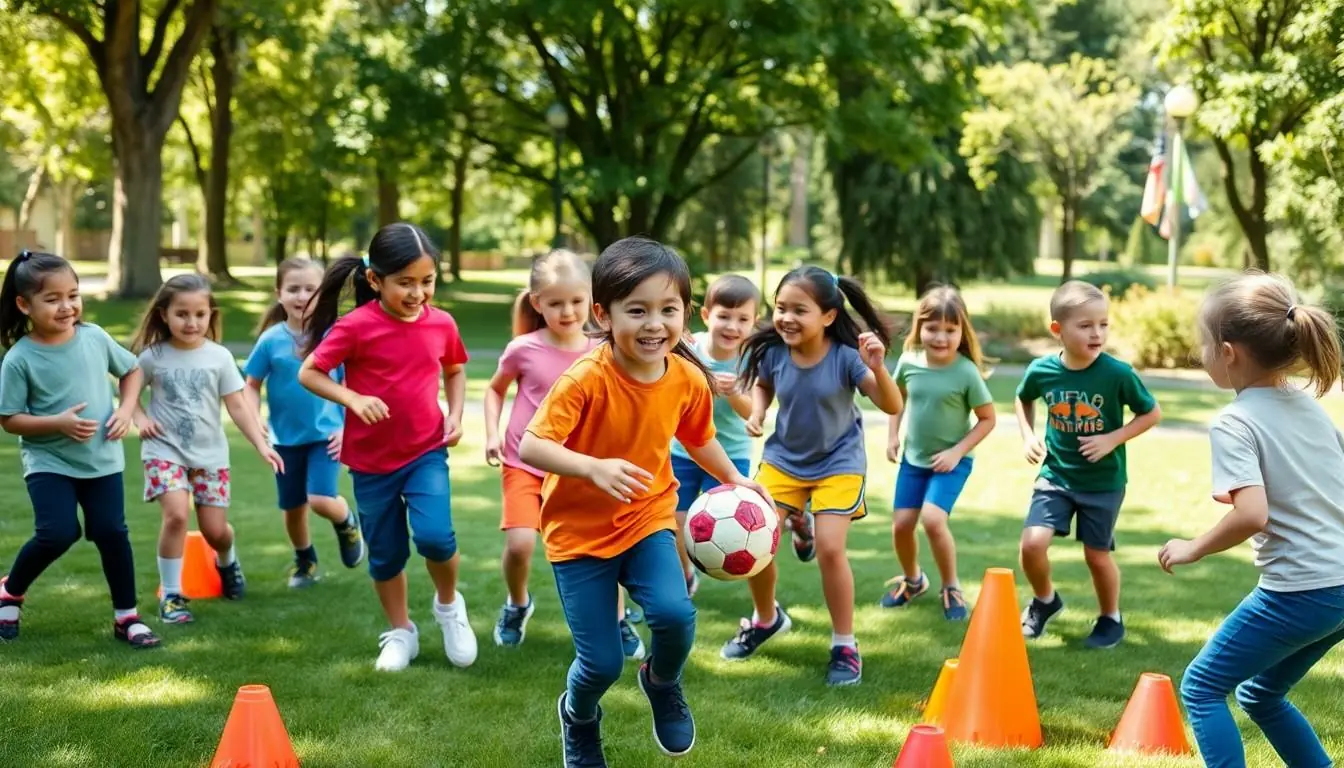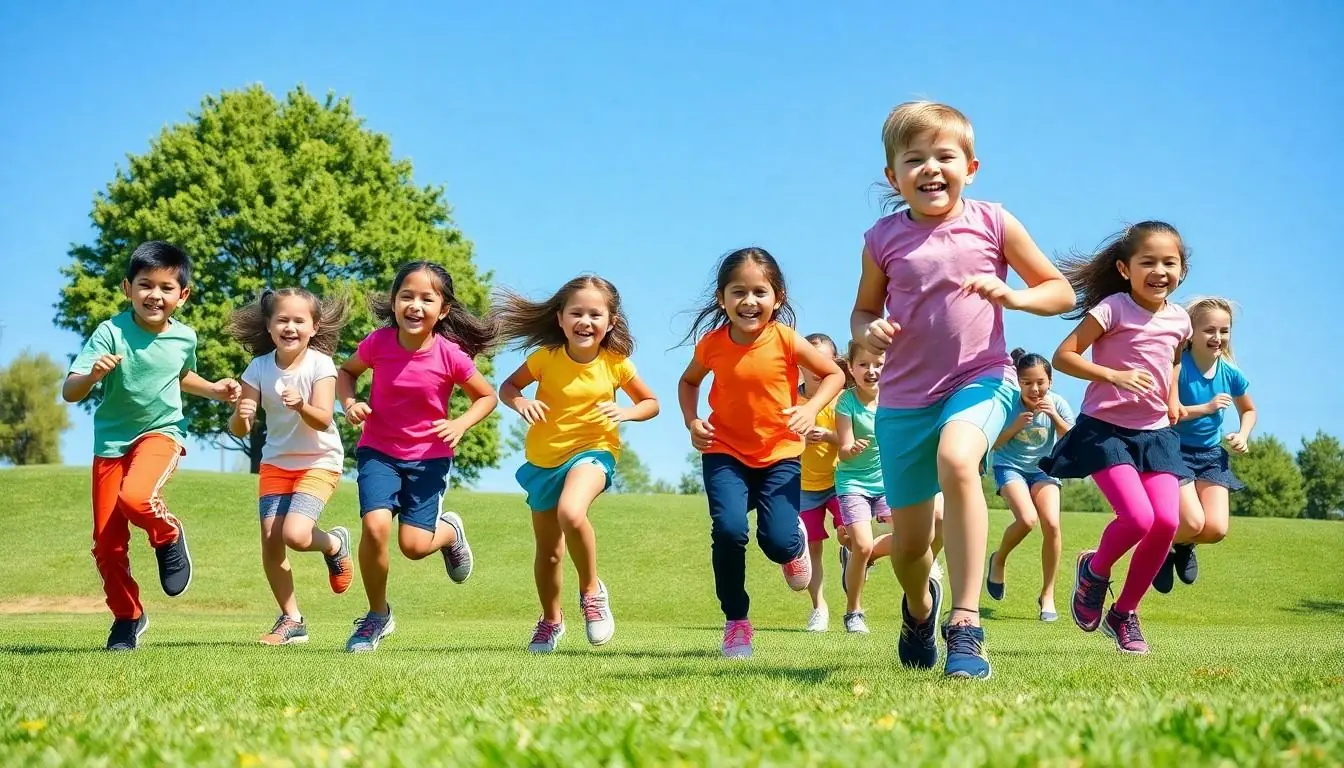In a world where kids are glued to screens, dynamic physical education is the superhero that swoops in to save the day. Imagine elementary school children bouncing off the walls—not from sugar, but from the excitement of engaging physical activities that promote health and teamwork. This isn’t just about dodging balls; it’s about creating a generation that runs, jumps, and plays their way to better health and confidence.
Dynamic physical education isn’t just a curriculum; it’s a vibrant adventure that transforms the classroom into an arena of fun and fitness. With the right tools, like an engaging ePub, educators can turn every lesson into a lively experience that keeps kids moving and laughing. So, let’s dive into how this approach can energize young minds and bodies while making physical education the highlight of their school day. After all, who said learning can’t be a blast?
Table of Contents
ToggleOverview of Dynamic Physical Education
Dynamic physical education transforms traditional PE programs by encouraging active participation among elementary school children. Educational models focus on engaging practices that prioritize health, teamwork, and confidence. Programs incorporate varied physical activities that cater to diverse interests, making lessons enjoyable and impactful.
Dynamic physical education emphasizes movement, promoting essential skills such as coordination and agility. Students experience outdoor games and group challenges that foster cooperation while improving physical fitness. This approach shifts attention away from sedentary behavior linked to screens and social media.
An engaging ePub serves as a vital resource for educators, providing innovative lesson plans and activities. Teachers can find tools to create activities that captivate students’ interest while addressing physical development goals. Interactive elements inspire creativity, encouraging students to explore new sports and challenges.
Dynamic physical education aligns with current health guidelines, aiming to meet daily physical activity recommendations for children. Incorporating fun experiences enhances motivation, while also building a positive attitude toward fitness that lasts a lifetime.
Successful programs focus on inclusivity, ensuring every child participates regardless of ability level. By tailoring activities to various skill levels, dynamic physical education fosters a sense of belonging. Children develop friendships through collaboration and support during physical activities.
Overall, dynamic physical education prepares children for healthier lifestyles. By transforming the learning environment, educators help students cultivate a love for movement that extends beyond school. Engaging resources and innovative practices play a crucial role in making this approach a memorable experience for all involved.
Importance of Physical Education for Children
Dynamic physical education serves as a crucial element in a child’s overall development, addressing both physical and emotional well-being. Engaging children in physical activities supports health benefits while laying a foundation for lifelong fitness.
Benefits of Physical Activity
Physical activity significantly improves children’s health by enhancing cardiovascular fitness, strengthening muscles, and fostering overall physical growth. Regular engagement reduces the risk of obesity and chronic diseases while positively impacting mental health. Kids who participate actively tend to show better focus and improved academic performance. Social interactions during team activities help build friendships and enhance communication skills. Enjoying movement also promotes cooperation, making it easier for children to connect with peers and learn valuable life skills.
Role in Child Development
Physical education plays a vital role in developing critical motor skills and coordination among children. Activities like running, jumping, and throwing enhance physical capabilities while promoting confidence and self-esteem. This discipline encourages discipline and perseverance, which are essential traits for personal success. Exposure to various sports helps children discover personal interests, leading to healthier lifestyles in adulthood. The inclusive nature of dynamic physical education fosters a sense of belonging, ensuring all children, regardless of ability, can thrive and flourish in shared experiences.
Features of the Epub Format
The ePub format offers unique benefits specifically for dynamic physical education resources designed for elementary school children. This format enhances both accessibility and interactivity.
Accessibility and Convenience
Accessing ePub files is simple for educators and students. Devices like tablets and eReaders support these files, allowing easy distribution across various platforms. Multiple students can enjoy the same resource simultaneously, eliminating the need for printed copies. Ease of navigation within ePub files enables quick retrieval of specific activities or information. Readers can adjust text size for clearer visibility, making resources more user-friendly for all students, including those with visual impairments. Incorporating images and links increases engagement and understanding. Overall, ePub enhances the learning experience by providing convenient access to dynamic physical education materials.
Interactive Elements
Interactive elements within ePub files enrich the learning experience. Activities may include quizzes and videos that encourage active participation. Multimedia components can capture students’ attention and motivate them to engage in physical activities. Animations and interactive diagrams further explain concepts, making lessons more understandable. Such features cater to different learning styles, enhancing retention of skills and knowledge. Dynamic assessments, like self-check tools, allow students to monitor their progress. Integration of social sharing capabilities enables collaboration among peers, promoting a stronger sense of community. Overall, these interactive elements elevate the educational experience, aligning with the principles of dynamic physical education.
Key Components of Dynamic Physical Education Programs
Dynamic physical education programs incorporate essential elements aimed at nurturing children’s physical and emotional growth. These components include well-structured curriculum design and diverse teaching strategies.
Curriculum Design
Curriculum design focuses on engaging and varied activities. It addresses different interests, ensuring broad appeal among elementary school children. Lessons often feature outdoor games, team challenges, and skill-building exercises that promote fitness and fun. Programs align with health guidelines, incorporating age-appropriate activities that fulfill daily physical activity requirements. Inclusivity holds great importance within the curriculum, allowing every child to participate based on their ability level. This approach fosters a sense of belonging and encourages collaboration among students.
Teaching Strategies
Effective teaching strategies enhance student engagement and participation. Variety plays a crucial role; teachers employ methods like cooperative learning, hands-on activities, and technology integration to capture students’ attention. Creating a supportive environment boosts confidence and motivation, allowing children to explore their interests without fear of judgment. Frequent feedback reinforces positive behaviors and progress, encouraging ongoing improvement. Flexible pacing accommodates individual learning needs, ensuring that all students benefit fully from physical education activities. Incorporating elements such as reflection and goal-setting empowers children to take ownership of their fitness journey.
Assessment and Evaluation in Dynamic Physical Education
Assessment and evaluation form essential components of dynamic physical education, allowing educators to track progress and enhance student engagement.
Measuring Student Progress
Measuring student progress in dynamic physical education involves various methods. Educators can use fitness assessments such as the Presidential Youth Fitness Program to evaluate cardiovascular endurance, flexibility, and muscular strength. Observational checklists monitor skills during activities and provide insights into individual and group performance. Pre and post-assessments reveal growth and areas needing improvement. Moreover, student participation rates and feedback from performance in team challenges contribute to a well-rounded understanding of their progress. Engaging students in self-evaluation fosters ownership, encouraging them to set and achieve personal fitness goals.
Feedback Mechanisms
Feedback mechanisms enhance the learning experience in dynamic physical education. Continuous feedback allows educators to address specific strengths and weaknesses. Frequent verbal and written feedback supports students’ growth and helps reinforce positive behaviors. Peer feedback promotes collaboration and builds teamwork skills. Incorporating technology, such as fitness apps that track performance, facilitates immediate feedback and encourages progress. By creating a supportive environment focused on constructive criticism, educators motivate students to improve while fostering a lifelong appreciation for health and fitness. Regular check-ins on individual goals help maintain motivation and accountability among students.
Conclusion
Dynamic physical education is essential for fostering a healthier and more active lifestyle among elementary school children. By integrating engaging activities and innovative resources like ePub files, educators can create an environment that motivates students to participate and thrive. This approach not only enhances physical fitness but also promotes social skills and emotional well-being.
With a focus on inclusivity and diverse interests, dynamic physical education ensures every child finds joy in movement. As children develop essential skills and confidence through fun and interactive lessons, they’re more likely to carry these positive habits into adulthood. Ultimately, prioritizing dynamic physical education can transform the school experience, making fitness a fundamental and enjoyable part of children’s lives.





